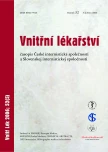-
Medical journals
- Career
Pathogenesis of the connective tissue in diabetes
Authors: J. Škrha
Authors‘ workplace: III. interní klinika 1. lékařské fakulty UK a VFN, Praha, přednosta prof. MUDr. Štěpán Svačina, DrSc., MBA
Published in: Vnitř Lék 2006; 52(5): 446-450
Category: Diabetes and other subjects (infection, dermatovenerology and rheumatology) Hradec Králové 3 to 4 June 2005
Overview
Non-enzymatic glycation and oxidative stress are main contributors in pathogenesis of the connective tissue changes in diabetes. Properties of separate parts in the connective tissue and particularly those of intercellular matrix may be impaired by both mechanisms. In addition, changes in microcirculation including endothelial dysfunction and also diabetic neuropathy further aggravate tissue impairment. Despite known pathogenic mechanisms in development of diabetic microangiopathy there are series of unresolved questions in the pathogenesis of diabetic skin disorders.
Key words:
diabetes mellitus - connective tissue - protein glycation - oxidative stress
Sources
1. Rask-Madsen Ch, He Z, King GL. Mechanisms of diabetic microvascular complications. In: Kahn CR (ed). Joslin´s Diabetes mellitus. 14th ed. Philadelphia: Lippincott Williams & Wilkins 2005 : 823-838.
2. Brownlee M. Advanced glycation end products in diabetic complications. Curr Opin Endocrinol Diabetes 1998; 3 : 291-297.
3. Reihsner R., Meilling M, Pfeiler W et al. Alterations of biochemical and two-dimensional biomechanical properties of human skin in diabetes mellitus as compared to effects of in vitro non-enzymatic glycation. Clin Biomechanics 2000; 15 : 379-386.
4. Schleicher E, Nerlich A. The role of hyperglycemia in the development of diabetic complications. Horm Metab Rev 1996; 28 : 367-373.
5. Delbridge L, Ellis CS, Robertson K et al. Non-enzymatic glycosylation of keratin from the stratum corneum of the diabetic foot. Brit J Dermatol 1985; 112 : 547-554.
6. Sehnalová H, Záhejský J. Sledování neenzymatické glykace epidermálního keratinu. Čs Dermatol 1991; 66 : 25-30.
7. Sehnalová H, Záhejský J. Charakteristika glykované bílkoviny keratinu. Čs Dermatol 1992; 67 : 29-33.
8. Lateef H, Stevens MJ, Varani J. All-trans-retinoic acid suppresses matrix metalloproteinase activity and increases collagen synthesis in diabetic human skin in organ culture. Am J Pathol 2004; 165 : 167-174.
9. Ceriello A, Dello Russo P, Curcio F et al. Acetylsalicylic acid and lysine inhibit protein glycosylation in vitro. Diabetes Metabolism 1984; 10 : 128-129.
10. Ortwerth BJ, Olesen PR. Glutathione inhibits the glycation and cross-linking of lens protein by ascorbic acid. Exp Eye Res 1988; 47 : 737-740.
11. Khatani M, Suldan Z, David D et al. Inhibitory effects of pyridoxal phosphate, ascorbate and aminoguanidine on nonenzymatic glycosylation. Life Sci 1988; 43 : 1725-1731.
12. Škrha J. Oxidační stres a diabetes mellitus. In: Perušičová J (ed). Trendy soudobé diabetologie. Praha: Galén 1998; 1 : 61-88.
13. Ceriello A, dello Russo P, Amstad P et al. High glucose induces antioxidant enzymes in human endothelial cells in culture. Diabetes 1996; 45 : 471-477.
14. Sharpe PC, Liu WH, Yue KKM et al. Glucose-induced oxidative stress in vascular contractile cells. Diabetes 1998; 47 : 801-809.
15. Kawamura N, Ookawara T, Suzuki K et al. Increased glycated Cu,Zn-superoxide dismutase levels in erythrocytes of patients with insulin-dependent diabetes mellitus. J Clin Endocrinol Metab 1992; 74 : 1352-1354.
16. Kilanczyk E, Bryszewska M. The effect of melatonin on antioxidant enzymes in human diabetic skin fibroblasts. Cell & Molec Biol Lett 2003; 8 : 333-336.
17. Tesfamariam B, Cohen RA. Free radicals mediate endothelial cell dysfunction caused by elevated glucose. Am J Physiol 1992; 263: H321-H326.
18. Nakai K, Kubota Y, Kosaka H. Inhibition of nuclear factor kappa B activation and inducible nitric oxide synthase transcription by prolonged exposure to high glucose in the human keratinocyte cell line HaCaT. Brit J Dermatol 2004; 150 : 640-646.
19. Chang CH, Tsai RK, Wu WC et al. Use of dynamic capillaroscopy for studying cutaneus microcirculation in patients with diabetes mellitus. Microvasc Res 1997; 53 : 121-127.
20. Prázný M. Využití laser Doppleru při vyšetření tkáňové perfuze. Diabetologie, metabolismus, endokrinologie, výživa 2000; 3 : 111-116.
21. Škrha J. Patofyziologie a patogeneze diabetické neuropatie. Vnitř Lék 2005; 51(Suppl 1): S67-S72.
Labels
Diabetology Endocrinology Internal medicine
Article was published inInternal Medicine

2006 Issue 5-
All articles in this issue
- The Nosocomial Infections and Diabetes
- Diabetes mellitus and immunization
- A role of diabetologist in management of infections in diabtics
- Pathogenesis of the connective tissue in diabetes
- Metabolic PPAR receptors and skin
- Diabetic skin changes from the dermatological point of view
- Healing of skin lesions in diabetic foot syndrome during hospitalization
- Infections and diabetic foot syndrome in field practice
- Sodium Hyaluronate and an Iodine Complex - Hyiodine® - New Method of Diabetic Defects Treatment
- Urinary tract infection in patients with diabetes mellitus
- Respiratory infections and inhalation insulin therapy
- Effects of insulin on glucose metabolism in sepsis
- Internist's view on skin manifestations of hyperlipidemia in diabetic patients
- Mycoses and diabetes
- Skin complications of diabetes mellitus therapy
- Diffuse idiopathic skeletal hyperostosis and its relation to metabolic parameters
- Rheumatologic manifestations in diabetes
- Metabolic bone diseases and diabetes
- Gout and diabetes
- Glucocorticoids and diabetes mellitus
- Anagrelide in the treatment of essential thrombocythemia (ET) and other myeloproliferative disorders with thrombocythemia based on data from patient register in the CR
- Internal Medicine
- Journal archive
- Current issue
- Online only
- About the journal
Most read in this issue- Diabetic skin changes from the dermatological point of view
- Glucocorticoids and diabetes mellitus
- Diffuse idiopathic skeletal hyperostosis and its relation to metabolic parameters
- Skin complications of diabetes mellitus therapy
Login#ADS_BOTTOM_SCRIPTS#Forgotten passwordEnter the email address that you registered with. We will send you instructions on how to set a new password.
- Career

